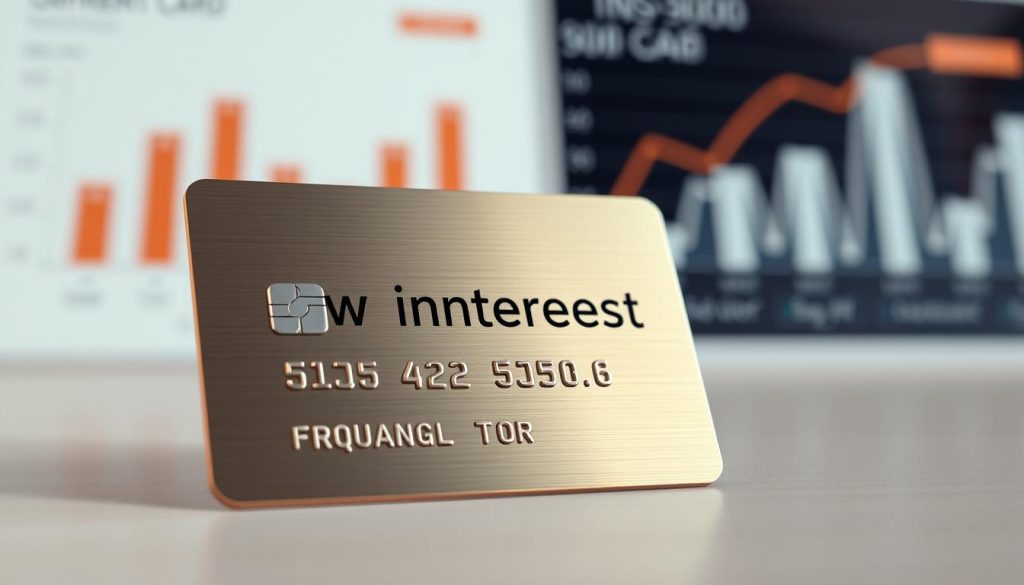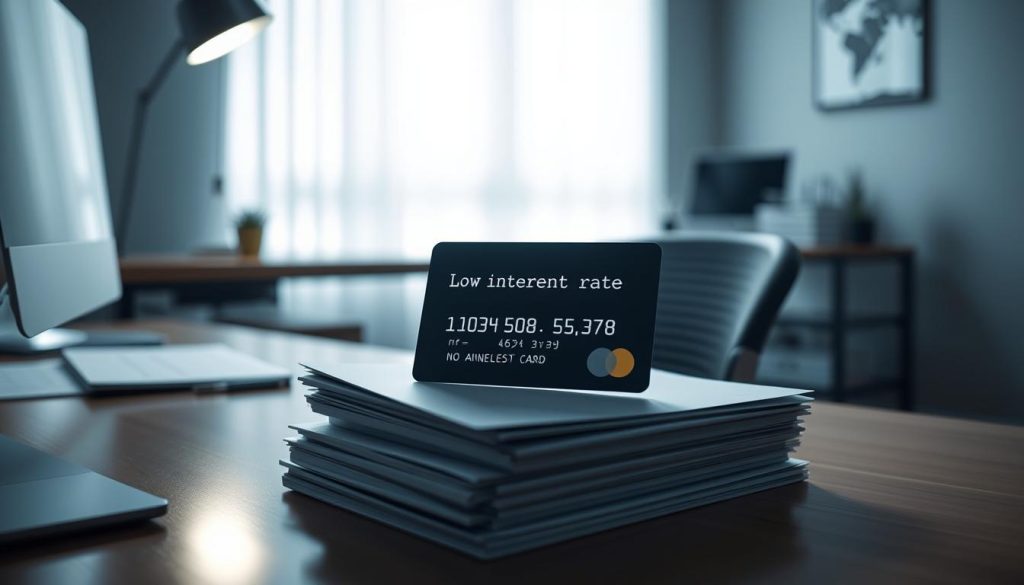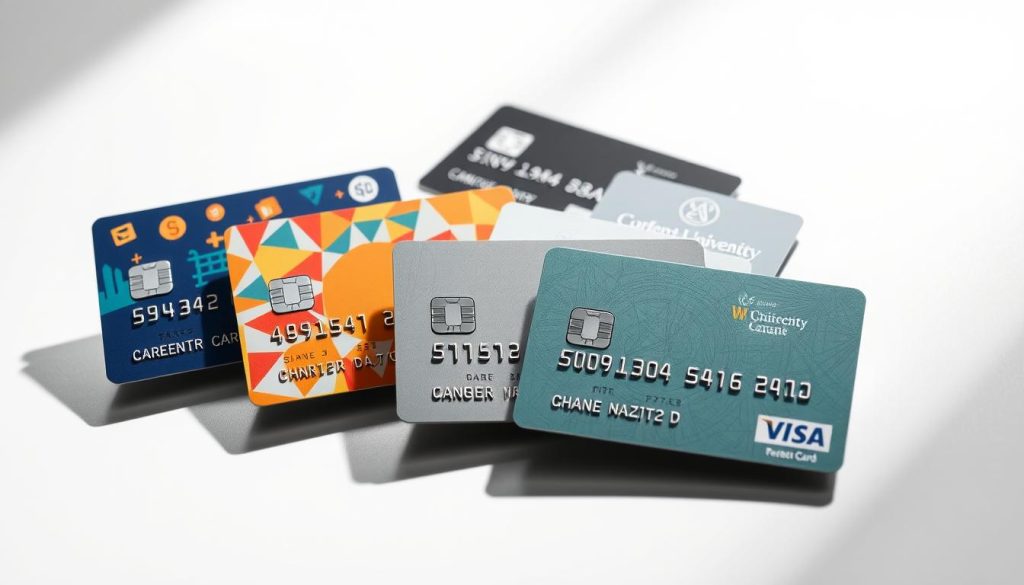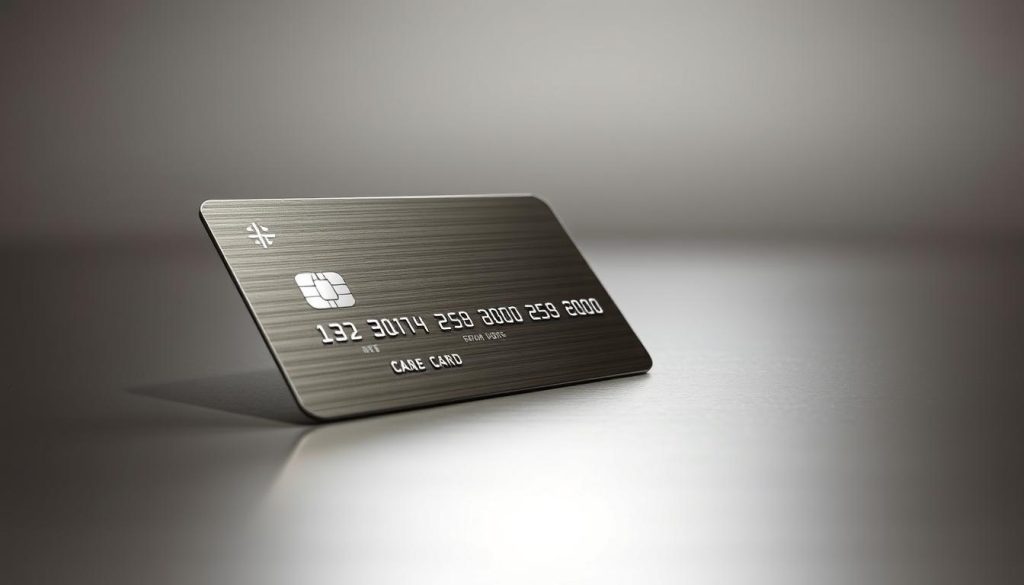Choosing the right credit card is key to managing your finances well. There are many options, but low-interest credit cards stand out. They let you borrow money at a lower cost, which is great for managing debt.
Credit card interest rates can really affect your money situation. Picking a low-interest credit card is a smart move.

Learning about low-interest credit cards can help you decide wisely. They can lower borrowing costs and make paying off debt easier. With the right card, you can control your finances and reach your goals.
Credit card interest rates are important for the cost of borrowing. Low-interest cards offer a cheaper way to borrow.
Introduction to Low-Interest Credit Cards
When looking at options, it’s important to know the pros and cons of low-interest credit cards. This knowledge helps you choose the best card for your needs. Whether you want to consolidate debt or make a big purchase, a low-interest card can be more affordable.
Understanding credit card interest rates is key to making a good choice. With the right knowledge, you can confidently explore low-interest credit cards.
Key Takeaways
- Low-interest credit cards offer a way to borrow money at a lower cost
- Understanding credit card interest rates is crucial for making an informed decision
- Low-interest credit cards can help you reduce the cost of borrowing
- Choosing the right low-interest credit card can help you achieve your financial goals
- Low-interest credit cards can provide a more affordable solution for managing debt
- It’s essential to consider the pros and cons of low-interest credit cards before making a decision
Understanding Low-Interest Credit Cards
Low-interest credit cards can help you manage your money better. They offer lower borrowing costs and better ways to handle debt. Knowing what makes a credit card low-interest is key.
A low-interest credit card has a lower annual percentage rate (APR) than most. The APR depends on your credit score, income, and debt. It’s crucial to note that rates can be fixed or variable, each with its own benefits and drawbacks.
When looking at low-interest credit cards, consider these points:
- Interest rate type: variable or fixed
- APR: the lower, the better
- Fees: look for cards with minimal or no fees
- Introductory offers: some cards offer 0% APR for a promotional period
Understanding these factors helps you choose the right low-interest credit card.

Current Market Trends in Credit Card Interest Rates
When you think about getting a credit card, knowing the credit card market trends is key. The rates on credit cards change with the economy. Now, there are more low-interest credit card offers available, which is great for you.
Here are some credit card market trends you should know:
- More competition among credit card companies means better deals for you.
- There are more low-interest credit card offers now, helping you handle your debt.
- Credit cards are focusing more on rewards like cashback and travel points.
Knowing these trends can guide you in picking the best credit card. With the right

Benefits of Low-Interest Credit Cards
Using a low-interest credit card offers many benefits for managing your money. One key advantage is the lower cost of borrowing. With a lower interest rate, you’ll save money on interest charges over time. This means you can pay off your balance faster.
Low-interest credit cards also make debt easier to manage. By combining all your debt into one card, you simplify your payments. This is very helpful if you have many cards with high balances and rates.
Key Benefits
- Reduced interest charges
- Lower monthly payments
- Long-term credit card savings
Low-interest credit cards also help with long-term savings. By paying less in interest, you can save more money. This is great for building an emergency fund or saving for a big purchase.
In summary, low-interest credit cards are a smart choice for managing debt and saving money. They help you reach your financial goals and give you peace of mind.
When to Choose a Low-Interest Credit Card
Choosing a low-interest credit card can be a smart move. But, you should think about your spending habits and financial goals first. If you’re trying to pay off debt or make a big buy, a low-interest card might be best.
Low-interest credit cards are useful in some situations. For example, they can save you money on interest when buying big or consolidating debt. They’re also good for building credit or boosting your score. Here are some times when a low-interest card is a good pick:
- You want to consolidate high-interest debt into a single, lower-interest loan
- You need to make a large purchase and want to avoid high interest charges
- You’re trying to build credit or improve your credit score
When picking a credit card, look at your financial situation and goals. A low-interest card can help you save money and reach your financial targets. Always check the card’s terms and conditions. Look at interest rates, fees, and rewards too.
Comparing Low-Interest Credit Cards with Other Options
When looking at credit card comparison, you find many choices. Low-interest credit cards are popular, but they might not suit everyone. We’ll see how they compare to balance transfer, rewards, and cash back cards.
Choosing between a low-interest vs rewards credit card depends on your goals. If saving on interest is key, a low-interest card is ideal. But, if you prefer earning rewards or cash back, other cards might be better.
Balance Transfer Cards
Balance transfer cards have 0% introductory APRs. This lets you move your balance and avoid interest. They’re perfect for quickly paying off high-interest debt.
Rewards Credit Cards
Rewards credit cards give points, miles, or cash back on purchases. They’re great for those who use their card often. You can use rewards for travel, gift cards, or more.
Cash Back Cards
Cash back cards give a percentage of your purchases back. This is ideal for earning cash on daily buys. You get the money back as a credit or check.
The right credit card for you depends on your needs and goals. By comparing credit card comparison options, you can find one that saves money, earns rewards, or meets your financial objectives.
Qualification Requirements for Low-Interest Credit Cards
To get a low-interest credit card, you need to meet some requirements. Credit score requirements are key, as lenders check them to see if you’re trustworthy. A high credit score can get you a card with better terms.
Here are some common requirements for low-interest credit cards:
- A good credit score, typically above 700
- A stable financial history, with a steady income and minimal debt
- A low debt-to-income ratio, to show you can handle debt
- A history of on-time payments, to prove you’re responsible with credit
Meeting these low-interest credit card qualification requirements can get you a card with a low interest rate. It’s important to check your credit report and score before applying. This ensures you meet the lender’s standards.
Knowing the requirements and keeping a good credit score can boost your chances of approval. This can save you money on interest and help you reach your financial goals.
Hidden Costs and Fees to Watch For
When looking at low-interest credit cards, don’t just focus on the interest rate. Credit card fees can quickly add up. Annual fees can range from $50 to $500 or more, depending on the card.
Other costs include late payment penalties and balance transfer fees. These can be steep. It’s important to pay on time and know the balance transfer terms.
Here are some common fees to watch for:
- Annual fees: $50 to $500 or more
- Late payment penalties: $25 to $38 or more
- Balance transfer fees: 3% to 5% of the transferred amount
Knowing these low-interest credit card costs and credit card fees helps you make a smart choice. Always read the fine print and ask questions about fees.
Strategies for Using Your Low-Interest Credit Card
To get the most from your low-interest credit card, use it wisely. This means managing how much you charge, paying on time, and avoiding extra interest. Using your low-interest credit card well can save you money and help you reach your financial goals.
Here are some credit card strategies to remember:
- Keep your credit utilization ratio below 30% to maintain a healthy credit score.
- Make more than the minimum payment each month to pay off your balance faster.
- Avoid making late payments, as they can lead to interest charges and damage your credit score.
By following these credit card strategies, you can make the most of your low-interest credit card. Always check your statement and use any rewards or benefits your card offers.
With smart low-interest credit card usage and credit card strategies, you can manage your finances better. Always use your credit card responsibly and make smart choices to reach your financial goals.
Impact on Your Credit Score
Using a low-interest credit card can greatly affect your credit score. It’s key to know how to use it wisely. Your credit score helps decide the interest rates you get and if you can get credit. Using a low-interest card responsibly can boost your score.
When you use a low-interest card, credit utilization matters a lot. Keeping your balance low compared to your limit can improve your score. For instance, if your limit is $1,000, aim to keep your balance under $300.
Payment history is also crucial. Paying on time is vital for a good credit score. Late payments can hurt your score. So, set up reminders or automate payments to show you’re responsible.
- Keep your credit utilization ratio low
- Make on-time payments
- Monitor your credit report for errors
By following these tips, you can use your low-interest card to improve your credit score. This helps keep your score healthy and strong.
Common Misconceptions About Low-Interest Credit Cards
There are many low-interest credit card myths that can confuse people. One big myth is that these cards are only for those with bad credit. But, many low-interest credit cards are open to people with good credit scores.
Another myth is that these cards come with high fees. While some may have fees, many don’t. Always check the terms and conditions before applying.
Here are some common low-interest credit card myths and the truth:
- Low-interest credit cards are only for people with poor credit: False. Many low-interest credit cards are available to people with good credit scores.
- Low-interest credit cards have high fees: False. While some low-interest credit cards may have fees, many others do not.
- Low-interest credit cards are not rewarding: False. Many low-interest credit cards offer rewards programs, such as cash back or travel points.
Knowing the truth about these credit card misconceptions helps you make better choices. You can find a low-interest credit card that fits your needs.
How to Apply for a Low-Interest Credit Card
Getting a low-interest credit card is easy if you’re ready. Knowing the steps to apply can help you get approved. You’ll need to share personal and financial details to show you’re a good candidate.
To start, collect the needed documents like your social security number and proof of income. You can apply online, by phone, or in person, depending on the issuer. The issuer will check your credit to decide on the interest rate and your credit limit.
Key Application Steps
- Check your credit score to ensure it’s in good standing
- Gather required documentation, such as proof of income and employment
- Submit your application and wait for a response from the credit card issuer
After applying, the issuer will review your info and decide. Approval times vary, but you’ll usually hear back in a few minutes to days. If approved, you’ll get your card in the mail and can use it immediately. Always read the fine print of your agreement before applying. Make sure you understand the interest rate, fees, and how to pay back.
Conclusion
Low-interest credit cards are a smart way to handle your money and save for the long run. By knowing the benefits, how to qualify, and best practices, you can get the most out of a low-interest credit card. This will help you control your financial future.
It’s important to use your low-interest credit card wisely. Avoid high fees and keep your credit use in check. With careful planning and discipline, you can lower your borrowing costs. This will also help you manage your debt better and possibly raise your credit score.
Look into the many options out there and pick a low-interest credit card that fits your financial needs and goals. By choosing wisely, you can use low-interest credit cards to your advantage. This is a big step towards financial health.
FAQ
What defines a low-interest credit card?
A low-interest credit card has an APR lower than the average market rate. The APR is the interest rate on any balance on your card.
How are credit card interest rates determined?
Interest rates are based on the Prime Rate, your credit score, and the issuer’s risk assessment. These factors help set the APR for each card.
What are the differences between variable and fixed interest rates?
Variable rates change over time, often with the Prime Rate. Fixed rates stay the same. Knowing the differences helps you choose the right rate for you.
How can a low-interest credit card benefit me?
Low-interest cards can save you money by reducing borrowing costs. They help manage debt and can save you money in the long run. This way, you pay off your debt faster.
When should I choose a low-interest credit card?
Choose a low-interest card if you carry a balance or have high-interest debt. They’re great for managing finances and paying off debt.
How do low-interest credit cards compare to other credit card options?
Low-interest cards focus on saving you money on interest. They differ from cards that offer rewards or cash back. The best card for you depends on your spending and financial goals.
What are the typical qualification requirements for a low-interest credit card?
To get a low-interest card, you need good credit, stable work, and a responsible credit history. Meeting these criteria can help you get the best rate.
What hidden costs and fees should I watch for with low-interest credit cards?
Low-interest cards may have fees like annual fees or late charges. Always read the fine print to avoid unexpected costs.
How can I use my low-interest credit card effectively?
To get the most from your card, manage your balance, pay on time, and avoid interest. Paying more than the minimum and using it for essential purchases can help.
How can a low-interest credit card impact my credit score?
Using a low-interest card can improve your credit score by showing responsible credit use. But, keep up with payments and check your report to ensure accuracy.
What are some common misconceptions about low-interest credit cards?
Some think low-interest cards have no fees or automatically improve credit scores. But, they’re not right for everyone. It’s key to understand their limitations.
How do I apply for a low-interest credit card?
To apply, gather your documents and fill out the application. Approval times vary, so be ready with all the needed info.


